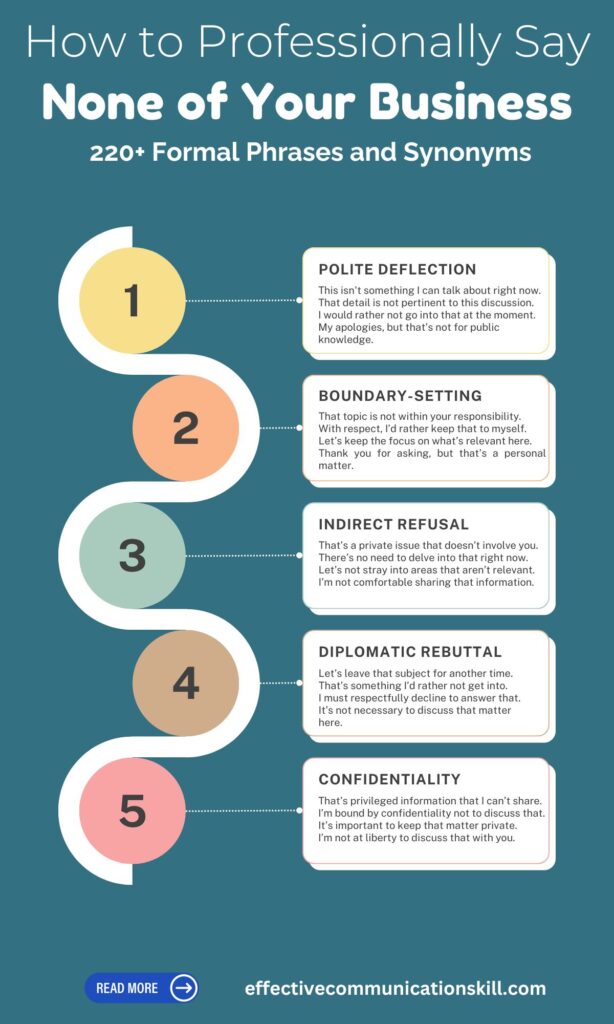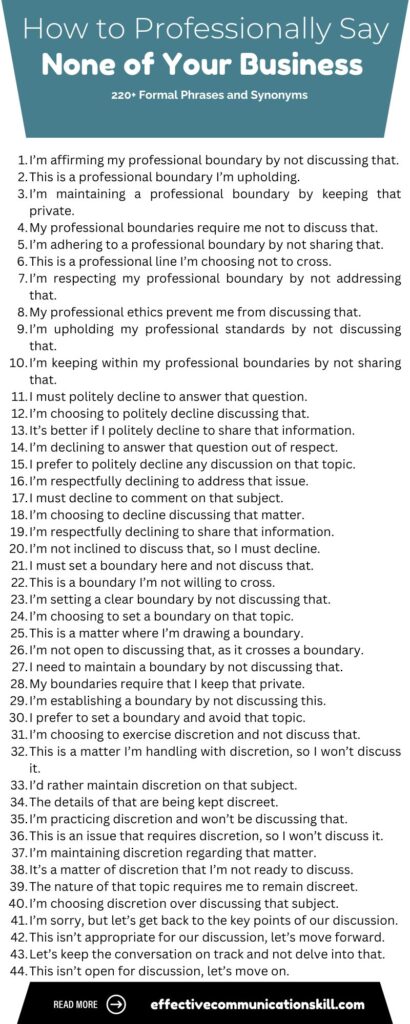How to Professionally Say None of Your Business
Having professional interactions can occasionally result in delicate circumstances, particularly when the queries deviate into irrelevant or personal topics.
It is crucial to know how to respond professionally and tactfully in these situations, whether you are answering questions about your personal life or ones that are outside your purview. It’s important to respond to inquiries respectfully and within your boundaries, not only by dodging them.
How to Professionally Say Mind Your Own Business – Here’s when knowing how to professionally say none of your business becomes crucial. Gaining proficiency in this ability allows you to respond politely but firmly, returning the conversation to topical subjects without creating awkward situations.
Respectful communication in the workplace is crucial, and this guide not only helps you maintain a professional manner but also sets a positive tone for your relationships.

How to Professionally Say None of Your Business
Here are some helpful tips to help you handle the situation effectively when saying none of your business politely:
Redirect the Conversation
Sometimes, the best way to maintain professionalism is by steering the conversation back to relevant topics. If a colleague asks about something personal or irrelevant, you can subtly guide the discussion back to work-related matters.
Example: A coworker might inquire, “So, how much did that new car set you back?” Instead of answering directly, you could respond with, “I’m really excited about it, but speaking of new things, have you seen the latest project update? I think it could use your input.”
Set Clear Boundaries
Setting boundaries is vital to ensure your personal and professional lines don’t blur. Politely, but firmly, indicating that a topic is off-limits can prevent future intrusions.
Example: If someone digs into your weekend plans, you could say, “I like to keep my personal life private, but I’m always open to discussing any work-related issues.”
Use Humor to Deflect
Humor can be an effective tool to deflect intrusive questions without offending the other person. A light-hearted response can shift the tone of the conversation and keep things amicable.
Example: If someone asks a prying question, you might reply with a smile, “Now, if I told you, I’d have to kill you!” followed by a laugh and a quick change of subject.
Express Discomfort Gently
Sometimes, being upfront about your discomfort with a question can be the most straightforward approach. It’s important to convey this gently to avoid sounding defensive or accusatory.
Example: When faced with a probing inquiry, you could say, “I’m not really comfortable discussing that, but I’d love to hear more about your thoughts on our current project.”
Turn the Question Back on Them
If someone asks a question that’s too personal, you can turn it back on them, prompting them to reflect on their inquiry. This technique can highlight the intrusiveness of their question without direct confrontation.
Example: If asked, “Why don’t you ever join us for after-work drinks?” you could respond with, “That’s an interesting question—why do you ask?” This often leads to the other person reconsidering their curiosity.
25 Formal Synonyms and example phrases for None Of Your Business
Explore these formal synonyms to say none of your business to navigate sensitive inquiries with finesse, keeping your responses both professional and discreet.
- This matter is private.
- This topic is confidential.
- This issue is not within your concern.
- I prefer to keep that information to myself.
- This does not pertain to you.
- This falls outside of your purview.
- I’d rather not disclose that.
- This is not something I wish to share.
- This matter is personal.
- I would prefer to keep that private.
- This is not relevant to your role.
- This is beyond your remit.
- This topic is not open for discussion.
- I am not at liberty to discuss that.
- This information is restricted.
- This subject is not within your jurisdiction.
- This does not concern you directly.
- This is a matter of personal discretion.
- I’m afraid I can’t share that information.
- This falls outside the scope of your involvement.
- This is a matter I’d prefer to handle privately.
- This is outside your sphere of responsibility.
- I prefer not to discuss that topic.
- This information is not for public knowledge.
- This is a matter of private concern.
200 Professional ways to Say None Of Your Business
Here are a wide array Polite sentences to say none of your business, to maintain your privacy and set boundaries effectively in any professional setting:
Polite Deflection
- I’m sorry, but that is not something I can discuss.
- That information is private, and I’d prefer not to share it.
- I’m afraid that’s not within your area of concern.
- It would be best to focus on the relevant matters at hand.
- I prefer to keep that particular matter confidential.
- This isn’t something I can talk about right now.
- That detail is not pertinent to this discussion.
- I would rather not go into that at the moment.
- My apologies, but that’s not for public knowledge.
- It’s not appropriate for me to share that information.
Respectful Boundary-Setting
- I appreciate your interest, but this is a private matter.
- That topic is not within your responsibility.
- I’d prefer to keep this between those directly involved.
- Thank you for asking, but that’s a personal matter.
- This falls outside the scope of what we can discuss.
- With respect, I’d rather keep that to myself.
- Your understanding is appreciated, but I can’t share that.
- This matter is sensitive and isn’t open for discussion.
- Let’s keep the focus on what’s relevant here.
- I hope you understand that this is not something I can disclose.
Professional Redirection
- That’s not information I can provide at this time.
- I’d like to steer our conversation back to the main topic.
- Unfortunately, I’m not in a position to discuss that.
- That aspect is outside of what we should cover today.
- Let’s keep our discussion on what’s within your purview.
- I recommend we focus on the tasks at hand instead.
- It’s better to leave that matter off the table for now.
- My preference is to keep that information confidential.
- This discussion would be more productive if we stayed on topic.
- I must decline to provide that detail.
Indirect Refusal
- That’s a private issue that doesn’t involve you.
- There’s no need to delve into that right now.
- I’m not inclined to discuss that, but thanks for understanding.
- That question is outside the scope of our current discussion.
- Let’s not stray into areas that aren’t relevant.
- It’s more appropriate to leave that matter unspoken.
- That’s something I’m keeping to myself, if you don’t mind.
- I’m not comfortable sharing that information.
- This is an internal matter that I prefer to handle privately.
- I believe that’s outside your area of concern.
Diplomatic Rebuttal
- This is not a subject open for further discussion.
- That’s a topic best left to those directly involved.
- It’s not necessary to discuss that matter here.
- I’m sorry, but I’m unable to provide that information.
- This is beyond the remit of what we’re discussing.
- There’s no need for you to concern yourself with that.
- I must respectfully decline to answer that.
- This isn’t the right time or place to talk about that.
- Let’s leave that subject for another time.
- That’s something I’d rather not get into.
Emphasizing Confidentiality
- I’m obligated to keep that information confidential.
- That’s privileged information that I can’t share.
- I’m bound by confidentiality not to discuss that.
- It’s important to keep that matter private.
- The confidentiality of that subject must be maintained.
- This matter is restricted to those with direct involvement.
- I’m not at liberty to discuss that with you.
- The privacy of that information is something I must uphold.
- That’s a confidential issue that I cannot disclose.
- Protecting the confidentiality of that topic is essential.
Redirecting Focus
- Let’s concentrate on the matters at hand instead.
- Our discussion should remain focused on the relevant issues.
- I think it’s best to leave that matter aside.
- Perhaps we can return to the main topic of conversation.
- We should stick to the points that concern everyone here.
- This isn’t pertinent to what we’re discussing right now.
- I suggest we keep our focus on the current agenda.
- Redirecting our attention back to the task at hand would be best.
- The matter in question is not relevant to this conversation.
- We should maintain our focus on the main discussion.
Subtle Denial
- I’d rather not go into that detail right now.
- That’s something I prefer to keep under wraps.
- The matter isn’t one I’m comfortable discussing.
- There’s no need to explore that particular topic.
- I’m choosing not to share that information.
- Let’s keep the conversation on what’s essential.
- That’s not something I wish to talk about.
- I think it’s best to move on from that subject.
- This is a topic that I’m not open to discussing.
- That detail isn’t necessary for this discussion.

Emphasizing Irrelevance
- That’s not relevant to what we’re working on.
- The matter in question doesn’t pertain to this conversation.
- That’s outside the scope of what’s being discussed.
- This is not something that needs to be addressed here.
- The topic you’re asking about isn’t related to our current work.
- That’s a matter unrelated to what we’re focused on.
- There’s no relevance to that subject in this context.
- Let’s keep the conversation on the pertinent issues.
- That’s something outside the purview of our discussion.
- The question you’re asking isn’t relevant to this situation.
Firm Politeness
- That’s not something I’m able to share at this time.
- It’s better if we focus on the matters that concern us both.
- I’m unable to provide that information due to its nature.
- It would be more appropriate not to discuss that.
- I’m afraid that information is not something I can divulge.
- That matter is not open for discussion.
- I prefer to keep that information private, thank you.
- Let’s not go into that particular topic.
- I’m not in a position to discuss that detail.
- It’s best to keep that matter off the table.
Emphasizing Privacy
- The details of that are personal, and I prefer to keep them private.
- This is a matter that I’m keeping confidential for now.
- I’m maintaining privacy on that subject, so I won’t be discussing it.
- It’s a private matter that I’m not ready to share.
- The specifics of that are something I’d like to keep private.
- My privacy on that matter is important, so I won’t go into detail.
- I prefer to keep my personal matters separate from work discussions.
- That’s a private issue I’m not discussing at this time.
- This is a personal topic that I won’t be addressing.
- I’m choosing to maintain privacy around that subject.
Courteous Non-Disclosure
- Due to the nature of the information, I’m unable to share it.
- I’m not in a position to disclose that information right now.
- For confidentiality reasons, I must refrain from discussing that.
- I’m obligated to keep that information under wraps.
- I’m sorry, but I can’t provide details on that.
- Disclosing that information isn’t appropriate at this time.
- The details of that are not available for discussion.
- I’m not permitted to share that information.
- The information you’re asking about is confidential.
- I’m sorry, but I’m unable to discuss that topic.
Professional Privacy
- That’s a professional boundary I prefer not to cross.
- This is a matter I’d rather not discuss in a work setting.
- I’m choosing to maintain a level of professional privacy on that.
- It’s best to keep that aspect of my work private.
- My professional boundaries require that I not discuss that.
- This is a private professional matter, not open for discussion.
- I’m sorry, but that’s not something I discuss professionally.
- I’m maintaining a professional boundary on that subject.
- This is a private work-related issue that I’m not discussing.
- That’s part of my professional discretion, and I’m not discussing it.
Diplomatic Evasion
- I’d prefer not to go into that at the moment.
- It’s not something I’m prepared to discuss right now.
- I’m going to pass on answering that question.
- The details of that aren’t something I wish to discuss.
- I think it’s better to avoid that topic for now.
- I’m choosing to remain silent on that subject.
- This is not a topic I’m open to discussing currently.
- I’d rather steer clear of that discussion.
- I prefer to leave that matter untouched.
- I’m not going to comment on that issue.
Emphasizing Relevance
- Let’s focus on what’s relevant to our work.
- That question isn’t relevant to our current discussion.
- This is beyond the scope of what we need to cover.
- I think it’s more relevant to discuss the main issues at hand.
- It’s important to stay on the topic that concerns us all.
- This matter doesn’t relate to what we should be focusing on.
- I believe we should keep our discussion relevant to the task.
- The question you raised isn’t pertinent to our objectives.
- Let’s keep the conversation relevant to our shared goals.
- This isn’t something that fits within our current focus.
Firm Redirection
- I’m unable to discuss that, but let’s focus on what’s essential.
- This isn’t open for discussion, let’s move on.
- I think it’s better if we redirect our attention to the main topic.
- Let’s not spend time on that, as it’s not relevant here.
- It’s best to leave that matter aside and continue with the agenda.
- That’s not something I can discuss, so let’s focus elsewhere.
- I’m sorry, but let’s get back to the key points of our discussion.
- This isn’t appropriate for our discussion, let’s move forward.
- Let’s keep the conversation on track and not delve into that.
- I prefer not to discuss that and would like to focus on what’s relevant.
Maintaining Discretion
- I’m choosing to exercise discretion and not discuss that.
- This is a matter I’m handling with discretion, so I won’t discuss it.
- I’d rather maintain discretion on that subject.
- The details of that are being kept discreet.
- I’m practicing discretion and won’t be discussing that.
- This is an issue that requires discretion, so I won’t discuss it.
- I’m maintaining discretion regarding that matter.
- It’s a matter of discretion that I’m not ready to discuss.
- The nature of that topic requires me to remain discreet.
- I’m choosing discretion over discussing that subject.
Respectful Boundary Setting
- I must set a boundary here and not discuss that.
- This is a boundary I’m not willing to cross.
- I’m setting a clear boundary by not discussing that.
- I’m choosing to set a boundary on that topic.
- This is a matter where I’m drawing a boundary.
- I’m not open to discussing that, as it crosses a boundary.
- I need to maintain a boundary by not discussing that.
- My boundaries require that I keep that private.
- I’m establishing a boundary by not discussing this.
- I prefer to set a boundary and avoid that topic.
Politely Declining
- I must politely decline to answer that question.
- I’m choosing to politely decline discussing that.
- It’s better if I politely decline to share that information.
- I’m declining to answer that question out of respect.
- I prefer to politely decline any discussion on that topic.
- I’m respectfully declining to address that issue.
- I must decline to comment on that subject.
- I’m choosing to decline discussing that matter.
- I’m respectfully declining to share that information.
- I’m not inclined to discuss that, so I must decline.
Affirming Professional Boundaries
- I’m affirming my professional boundary by not discussing that.
- This is a professional boundary I’m upholding.
- I’m maintaining a professional boundary by keeping that private.
- My professional boundaries require me not to discuss that.
- I’m adhering to a professional boundary by not sharing that.
- This is a professional line I’m choosing not to cross.
- I’m respecting my professional boundary by not addressing that.
- My professional ethics prevent me from discussing that.
- I’m upholding my professional standards by not discussing that.
- I’m keeping within my professional boundaries by not sharing that.
Examples Using Formal Synonyms for “None of Your Business”
Here are some expanded examples showcasing how to utilize formal synonyms and phrases for saying “none of your business” in various professional situations:
Redirecting an Off-Topic Question
Scenario: During a team meeting, a colleague asks about the details of your personal leave, which isn’t relevant to the discussion.
Formal Response: “I appreciate your curiosity about my time off; however, it’s a personal matter that I prefer to keep private. Let’s refocus on the project timeline and ensure we have everything in place to meet our upcoming deadlines. If you have any questions related to the project, I’m here to help.”
Maintaining Professional Boundaries
Scenario: A client asks for information about internal company decisions that they aren’t involved in.
Formal Response: “I understand that you’re interested in how we’re managing things internally, but that information is reserved for those directly involved in the decision-making process. What I can do is provide you with all the relevant details that impact our work together. I’m confident that will give you the insights you need for our partnership.”
Deflecting a Sensitive Topic
Scenario: A coworker inquires about your salary during a casual conversation.
Formal Response: “I prefer to keep details about my salary confidential as it’s a personal matter. However, I’m more than happy to discuss our upcoming project and how we can collaborate effectively to achieve our goals. I believe that’s a conversation that will benefit us both.”
Setting Clear Boundaries
Scenario: A colleague questions you about a personal matter during a work event.
Formal Response: “I like to keep my personal life separate from my professional environment, so I’d rather not discuss that. However, I’m really interested in hearing your thoughts on the latest team initiative. How do you think we can improve our approach to ensure success?”
Reaffirming Confidentiality
Scenario: Someone in the office asks you about a confidential project you’re working on.
Formal Response: “Due to the sensitive nature of this project, I’m not in a position to discuss the details right now. It’s important that we maintain confidentiality until the appropriate time. Once the information is ready to be shared, I’ll make sure you’re fully informed.”
Handling Persistent Inquiries
Scenario: A coworker repeatedly asks you about your weekend plans, pushing for details.
Formal Response: “I prefer to keep my personal plans private, but I appreciate your interest. Instead, let’s focus on the tasks we have lined up for next week. There’s a lot we can achieve if we plan strategically, and I’m excited to dive into that.”
Deflecting a Direct Question
Scenario: During a meeting, a colleague directly asks about your reasons for declining a recent invitation to a company event.
Formal Response: “I appreciate your understanding that my reasons for declining are personal and something I’d prefer to keep to myself. That said, I’m fully committed to the projects we have in the pipeline and would like to focus on how we can best meet our upcoming deadlines. Let’s channel our energy there.”
Politely Declining to Answer
Scenario: An employee from another department asks about the specifics of your department’s strategy, which is not something they need to know.
Formal Response: “I must politely decline to go into details about our department’s strategy at this time, as it’s not relevant to your role. However, if you have questions that relate directly to your responsibilities, I’m more than willing to help you with those. Let’s keep our conversation focused on areas where we can collaborate.”
Protecting Confidential Information
Scenario: During a discussion, someone asks you to share details about a confidential merger.
Formal Response: “I’m bound by confidentiality and therefore can’t share any details about the merger at this stage. It’s crucial that we respect the privacy of these discussions. However, I can provide you with information that’s already public, and I’m happy to answer any questions related to that.”
Avoiding Personal Disclosure
Scenario: A colleague asks about your personal financial situation during a lunch break.
Formal Response: “I tend to keep my personal finances private as it’s not something I’m comfortable discussing. That being said, I’m very interested in hearing more about your ideas for our next team project. I believe your insights could really add value to what we’re working on.”

Conclusion
In professional settings, knowing how to professionally say none of your business is crucial for maintaining boundaries while fostering respect and collaboration. By using the right language, you can navigate sensitive topics without offending others or creating tension.
The key is to be firm yet polite, ensuring that your responses are clear and respectful. Whether it’s deflecting a personal inquiry or setting a professional boundary, mastering this skill allows you to handle potentially awkward situations with grace and confidence, keeping your interactions both productive and professional.
